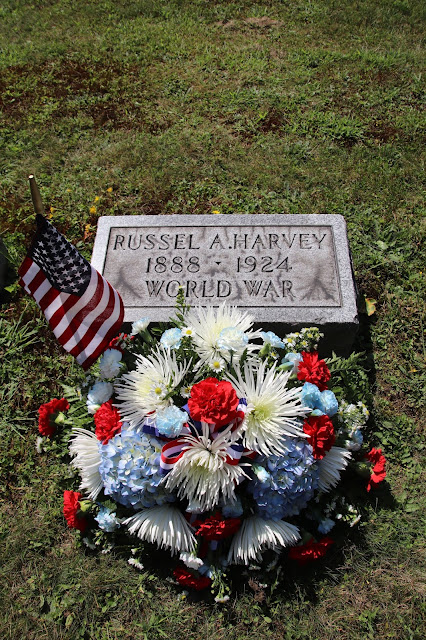16 September 2018
Erie, Pennsylvania
My great uncle, Archie Harvey, will never know how much he has
touched my life, and others too. Last year I was giving a presentation at the
Watson Curtze Mansion in Erie, Pennsylvania, for the Erie Society for
Genealogical Research. My brother, sister in law, one of my sons, and my
daughter in law were there, as I may have convinced them to attend—I thought it
was important that they hear Archie’s story. They all said they were glad that
they had attended and now knew what my work was about. A few weeks later our
Jamestown son came to my presentation at the Corry Area Historical
Society. A couple of cousins were there too. I know that I am fortunate
that so many family members have an interest in our Uncle Archie.
Roy Ward Hall, 28th
Division, 112th Infantry Regiment, Co. A.
After the presentation at the Watson Curtze Mansion, my brother said he had something for me.
The heavy object, wrapped in camouflage fabric, revealed a Doughboy helmet with
a red Keystone stenciled on it. My Uncle Roy Hall’s helmet from World War I—28th Division,
112th Infantry Regiment, Company A, the Keystone Division, the
Iron Division, the Bloody Bucket Division. I was overwhelmed by this heartfelt
precious gift from my brother.
Since the Keystone was used on the 28th Division’s
patch and helmet, one readily understands why it was called the Keystone
Division. Pennsylvanians learn in grade school how Pennsylvania was the
“Keystone State” from the early time of the development of the Thirteen
Colonies. General Pershing called the division the Iron Division, and
after reading With the 112th in France, A Doughboys Story of the War,
written by James A. Murrin in 1919, right after the war, I have no doubt why he
chose that name. The Germans called the division the Bloody Bucket.
During World War
I, the 28th Division was part of the Champagne-Marne,
Aisne-Marne (Fisme-Fismette), Oise Aisne, and the Meuse Argonne operations.
During the war, this division had a total of over 14,000 casualties, including
2,165 killed. Those figures only tell a part of their story.
When Secretary of
State Lansing saw the 28th Division in March 1918, he stated, “I
must congratulate the state of Pennsylvania upon the sturdy type of men who
compose this division. No finer specimens of manhood can be found in the armies
of the republic than the thousands which passed in review today. To see them
was an inspiration and impressed the deep conviction that with such defenders
the cause of liberty is safe.” [With the 112th in France,
Murrin, p. 41]
At the Aisne-Marne/Bois de Trugny engagement, a soldier in the 112th Regiment, wrote, “We’ve been to hell and back since I last wrote—to where men kill and
slay and die, and perish under a withering fire; where there is nothing of hope…”
[With
the 112th in France, Murrin, letter by unknown writer
quoted, July 1918, p.151].
At Fismes/Fismette, the 112th was “outnumbered at least
five to one by the force of Germans.” The men of Companies G and H put up a
brave fight. [With the 112th in France, Murrin, August 1918, p.
205]. Friend Ann Silverthorn’s great uncle was killed in this battle, and Friend Sandra’s
great uncle was killed in the Argonne Forest.
As Murrin says after the Armistice on November 11th, “…what
a great relief to know that the day has passed when machine guns and shrapnel
can maim and slay your own comrades; to know that those of us who have played
the game hard and lived, lived only by the grace of God—may look forward to
seeing old New York harbor, some day not far distant [Murrin, p. 344].
Erie, Corry, Meadville, Bear Lake, Oil City, and more--the soldiers of the 112th.
Uncle Roy Ward
Hall, my mother’s only brother, did return to America and lived a full life as
a businessman in Lottsville, Pennsylvania and Dunkirk, New York. As I have mentioned
before, he lived with shrapnel wounds in his hip the rest of his life after the
war.
Roy Ward Hall's doughboy helmet, World War I
Archie Harvey’s Dictionary
Recently my brother gave me another gift—somehow, he discovered
Archie’s well worn, leather bound dictionary, The New Webster Dictionary and Complete Vest
Pocket Library, published in 1914. Archie’s letters are well written and it made
sense that he owned one. His name is
neatly written on the inside cover, dated June 24th, 1917. Guernsey,
Iowa.
On the back cover of the dictionary, Archie wrote the word, "Zimbalon." Why? What is that? A complex zither, played especially in Hungary, according to Dictionary.com. Why did Archie write that word in this dictionary?
This date, June 24, 1917, is during the time that Archie was working as a farmhand in Iowa,
and after he tried to enlist. Since Archie’s
birthday was in May, I do not think it was a birthday gift. Something I want to
research is writing while at war. At one point Archie laments to his mother that
it isn’t easy to write without a desk, probably after a request to write more
often. I have often thought about how neatly Archie writes, with pen and ink.
Most letters from France during the war were written in pencil.
Archie Harvey's well-worn dictionary, The New Webster Dictionary and Complete Vest Pocket Library
Archie's handwriting--


































